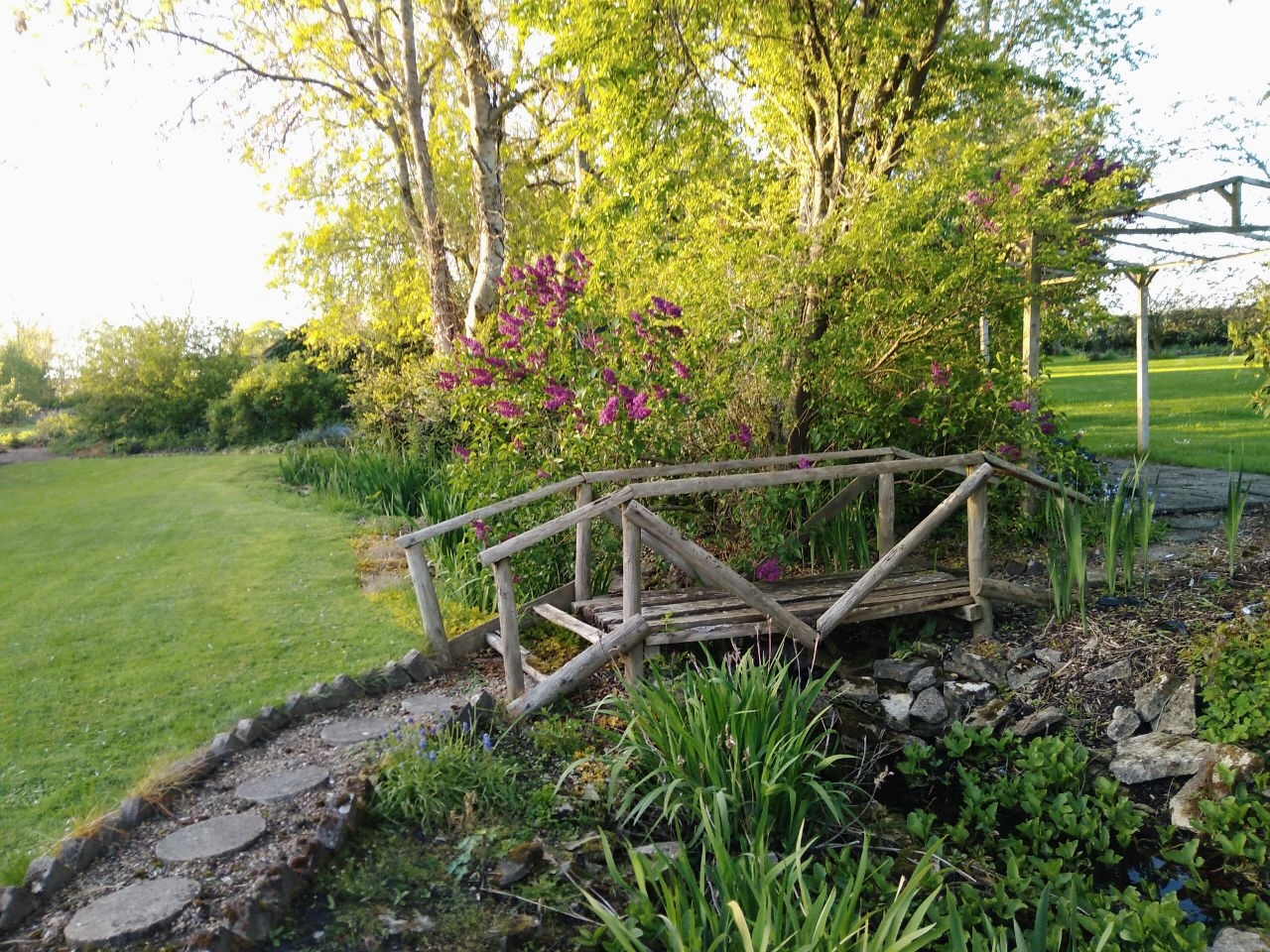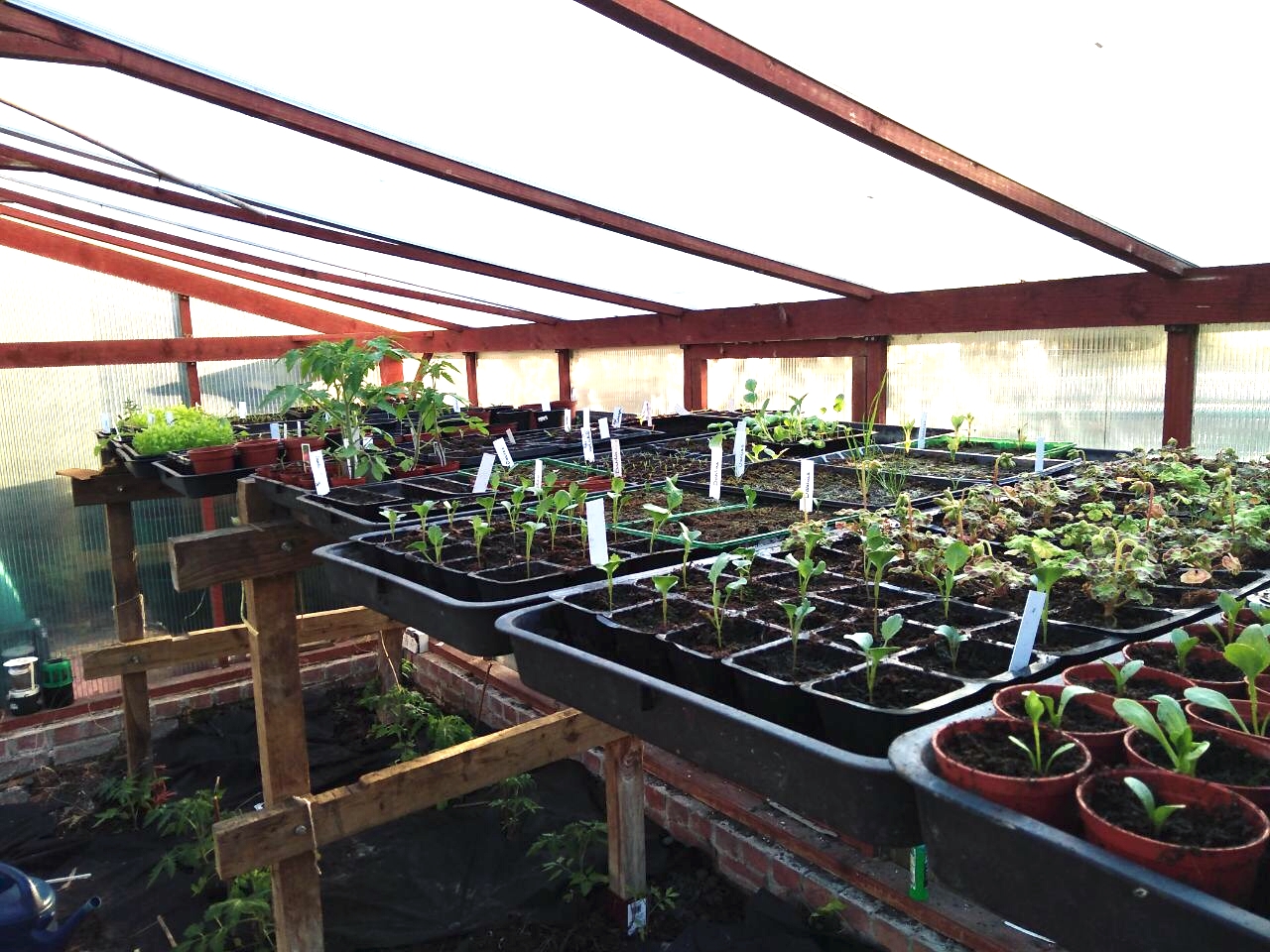













The grass grows very quickly at this time of year, especially if we have a lot of rain. And we have had a lot of rain recently so I need to cut it at least once per week. This task takes about half a day.
As spring rushes towards summer, trees and shrubs come into flower. The pink and white blossom of the Japanese cherry trees is always eagerly awaited. However it is gone very quickly, removed by strong winds and heavy rain. The same goes for the blossom on the pear, plum, apple and cherry trees. Fortunately the blossom wasn’t blown away before it was pollinated, so tiny fruits can be seen growing on the trees. Something to look forward to in the late summer and autumn.

At the moment we are awaiting the wonderful floral displays offered by the wisteria and the peonies. Peonies are a perennial plant which having flowered appear to die off, but each year they regrow and flower again. It is like welcoming back an old friend. The wisteria is a hardy climbing shrub spreading over the pergola. It produces long tassels of lavender blue flowers in late spring. It is rather late this year as spring has been cooler than usual. Also there are several honeysuckles, these climbing shrubs are just coming into flower and they fill the air with their wonderful fragrance particularly during the evening.
.jpg)
We supplement the flowering shrubs and perennials with a variety of annuals. Annuals are plants that grow, flower and die all in one season. We sowed seeds in trays of compost several weeks ago. They have been growing in the greenhouse and now that the risk of frost has passed we put them outside to harden off (to get used to being outside). They are now at the stage when they need to be planted into the flower beds. There are a lot of them. Earlier this week my wife and I planted 400 dahlias, 200 lavatera, 40 sunflowers, 200 French marigolds and many more. There still a lot more awaiting their turn.
We try to arrange our bedding plants (the general term for plants grown inside and then planted outside) so that the different heights and colours compliment each other. For instance we are filling the large bed nearest the conservatory with plants that will produce mainly white flowers but with a few lilac or lavender coloured specimens as well. We will see if this plan has worked in about 6 weeks.
We also grow vegetables. Some like carrots, beetroot, spinach and parsnips are sown directly into the ground. The white net over the carrots is there to try and prevent the carrot root fly laying its eggs on the carrots. If they do then the hatched larvae tunnel into the carrot and can make the carrot inedible.

Other vegetables are sown inside the greenhouse and then planted out after the risk of frost has passed. We have so far planted runner beans, broad beans, cauliflower, sprouts, corn, onions and leeks outside. The net over the cauliflower is there to try and prevent the cabbage white butterfly laying eggs on them. Their eggs hatch and caterpillars eat and destroy the plants.
Some vegetables are not really suited to growing outside in England. So the greenhouse is gradually filling up with tomato plants. The Polytunnel now has cucumbers and butternut squash plants as well as some early potatoes.
The majority of the potatoes are planted directly into the soil, but as they sprout, the tops have to be covered up with soil to keep them safe from frost.
In a few weeks we will begin to see our flowers and vegetables growing and I will update you with another article.
HERBS [hɜːbz] – ТРАВЫ:
Spinach [ˈspɪnɪʧ] — Шпинат
Parsnip [ˈpɑːsnɪp] — Пастернак
FLOWERS [ˈflaʊəz] – ЦВЕТЫ:
Wisteria [wɪˈstɪərɪə] — Глициния
Dahlia [ˈdeɪljə] — Георгин
Peony [ˈpiːənɪ] — Пион
Lavatera [ˌlævəˈtɪərə] — Лаватера
Marigold [ˈmærɪgəʊld] — Бархатцы
Sunflower [ˈsʌnflaʊə] — Подсолнух
Blossom [ˈblɒsəm] – Соцветие, цветок
Fragrance [ˈfreɪgrəns] – Аромат
PLANTS [plɑːnts] – РАСТЕНИЯ:
Seeds [siːdz] – Семена
Sprout [spraʊt] — Росток
Bedding plant [ˈbedɪŋ plɑːnt] — Саженец
Shrub [ʃrʌb] – Кустарник
Climbing shrub [ˈklaɪmɪŋ ʃrʌb] – Вьющийся кустарник
Tree [triː] – дерево
Tassels [ˈtæsəl] – Кисточки
Japanese cherry tree [ʤæpəˈniːz ˈʧerɪ triː] – Сакура, вишня
Annual [ˈænjʊəl] — Однолетнее растение
Perennial plant [pəˈrenɪəl plɑːnt] – Многолетнее растение
Runner beans [ˈrʌnə biːns] — Стручковая фасоль
Broad beans [brɔːd biːns] — Бобы
FRUITS [fruːt] – ФРУКТЫ:
Pear [peə] – Груша
Plum [plʌm] – Слива
Apple [æpl] – Яблоко
Honeysuckle [ˈhʌnɪsʌk(ə)l] — Жимолость
VEGETABLES [ˈveʤtəbəlz] – ОВОЩИ:
Tomato [təˈmɑːtəʊ] – Помидор
Cucumber [ˈkjuːkʌmbə] — Огурец
Carrot [ˈkærət] — Морковь
Beetroot [ˈbiːtruːt] — Свекла
Cabbage [ˈkæbɪʤ] – Капуста
Cauliflower [ˈkɒlɪflaʊə] — Цветная капуста
Butternut squash [ˌbʌt.ə.nʌt ˈskwɒʃ] — Мускатная тыква
Early potato [ˈɜː.li pəˈteɪ.təʊ] — Молодой картофель
Corn [kɔːn] — Кукуруза
OTHER GARDENING WORDS:
Soil [sɔɪl] — Почва
Greenhouse [ˈgriːnhaʊs] — Теплица
Polytunnel [pɒliˈtʌnəl] – Плёночный парник
To plant out [plɑːnt aʊt] – Высаживать
To pollinate [ˈpɒlɪneɪt] – Опылять
В этой статье мы рассмотрели много полезной лексики на тему садоводства. Чтобы лучше запомнить изученный вокабуляр, старайтесь чаще повторять новые слова и использовать их в своей речи. А для того чтобы ваша практика проходила наиболее эффективно, записывайтесь на занятия с Джоном!
Оставьте заявку и мы подберём удобное расписание для вашего обучения

